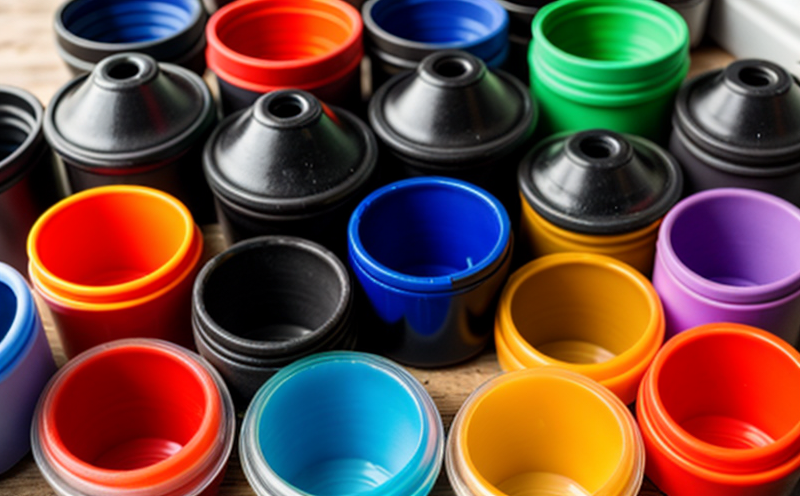ISO 175 Chemical Resistance Testing of Recycled Plastics
The ISO 175 chemical resistance test is an essential procedure for ensuring the durability and reliability of recycled plastics in a wide range of applications. This test evaluates how well recycled plastic materials withstand exposure to various chemicals, which can include solvents, detergents, oils, and other harsh substances that they might encounter during processing or use.
Recycling plastic requires precise control over chemical resistance because the properties of recycled plastics often differ from those of virgin polymers. This difference is due to factors such as varying concentrations of residual monomers, additives, and contaminants in the feedstock used for recycling. Understanding how these materials behave under different chemical conditions is crucial for designing products that perform reliably across various environments.
The ISO 175 test involves immersing a specimen made from recycled plastic into a solution containing the target chemical at specific temperature and time parameters. After exposure, the specimen's physical properties are measured to determine any changes caused by the chemical interaction. These measurements typically include tensile strength, elongation at break, impact resistance, and other mechanical tests.
Testing different batches of recycled plastic is vital for quality assurance in manufacturing processes where consistency is key. By conducting ISO 175 tests early in the supply chain, manufacturers can identify potential issues before they become costly problems later on. For instance, if a batch shows reduced tensile strength after exposure to certain chemicals, this information could prompt adjustments in recycling methods or sourcing practices.
The results of these tests are particularly important for industries such as automotive, construction, and consumer goods where durability under chemical stress is paramount. In the automotive sector, recycled plastics may be used in components exposed to engine oil and coolant; in construction, they might go into pipes handling aggressive chemicals like cleaning agents or industrial solvents.
Another critical aspect of ISO 175 testing pertains to regulatory compliance. Many countries have stringent standards regarding the use of recycled materials in certain industries, especially where safety is concerned. Demonstrating adherence to these regulations through rigorous testing can help businesses avoid penalties and maintain a competitive edge.
| Standard | Description |
|---|---|
| ISO 175:2018 | Detailed procedures for determining the chemical resistance of plastics using immersion tests. |
| ASTM D638-18 | Tensile testing methods which may complement ISO 175 results depending on application requirements. |
| EN 924:2017 | European equivalent that provides additional guidance specific to European market regulations. |
Understanding the scope of this testing requires familiarity with both ISO and ASTM standards, as well as local regulatory requirements. This ensures comprehensive coverage when performing these tests in diverse environments around the world.
In summary, ISO 175 chemical resistance testing provides critical insights into the performance characteristics of recycled plastics under exposure to various chemicals. Its importance spans across multiple sectors including automotive, construction, and consumer goods, making it an indispensable tool for ensuring product quality and compliance with international standards.
Why It Matters
The significance of ISO 175 chemical resistance testing lies in its ability to predict the long-term performance of recycled plastic materials across different environments. By simulating real-world conditions, this test helps manufacturers make informed decisions about material selection and process optimization.
- Material Selection: Testing ensures that recycled plastics chosen for specific applications will not degrade when exposed to chemicals present in their intended environment.
- Process Optimization: Identifying weaknesses early allows adjustments to the recycling process, thereby reducing waste and improving overall efficiency.
The impact of chemical resistance testing extends beyond just manufacturing. It also plays a role in enhancing product safety by ensuring that recycled plastics do not release harmful substances into the environment or human contact.
- Regulatory Compliance: Meeting regulatory requirements is crucial for avoiding fines and maintaining market access.
- Sustainability Goals: By using tested recycled materials, businesses can contribute positively to environmental sustainability goals while meeting consumer expectations for eco-friendly products.
In conclusion, ISO 175 chemical resistance testing is not just a technical requirement but also a strategic initiative that supports sustainable development and enhances product reliability in challenging environments.
Applied Standards
| Standard | Description |
|---|---|
| ISO 175:2018 | Detailed procedures for determining the chemical resistance of plastics using immersion tests. |
| ASTM D638-18 | Tensile testing methods which may complement ISO 175 results depending on application requirements. |
| EN 924:2017 | European equivalent that provides additional guidance specific to European market regulations. |
The use of these standards ensures consistency and accuracy in chemical resistance testing, making it easier for labs worldwide to compare results and adhere to international norms.
Quality and Reliability Assurance
- Consistency: ISO 175 tests help maintain consistent quality by ensuring that recycled plastics behave predictably across various chemical environments.
- Risk Management: Identifying vulnerabilities early allows for mitigation strategies to be implemented, reducing risks associated with material failure in use.
These measures contribute significantly to enhancing the overall reliability and safety of products made from recycled plastic materials. Regular testing ensures that these materials continue to meet stringent quality expectations over time.





